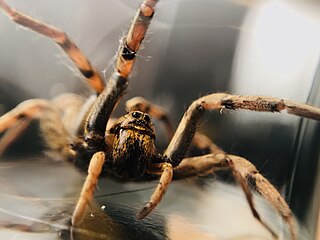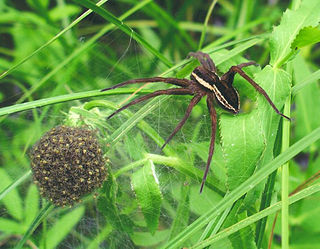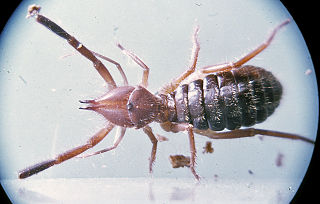
Wolf spiders are members of the family Lycosidae. They are robust and agile hunters with excellent eyesight. They live mostly in solitude, hunt alone, and usually do not spin webs. Some are opportunistic hunters, pouncing upon prey as they find it or chasing it over short distances; others wait for passing prey in or near the mouth of a burrow.

Solifugae is an order of animals in the class Arachnida known variously as camel spiders, wind scorpions, sun spiders, or solifuges. The order includes more than 1,000 described species in about 147 genera. Despite the common names, they are neither true scorpions, nor true spiders. Most species of Solifugae live in dry climates and feed opportunistically on ground-dwelling arthropods and other small animals. The largest species grow to a length of 12–15 cm (5–6 in), including legs. A number of urban legends exaggerate the size and speed of the Solifugae, and their potential danger to humans, which is negligible.

Ammotrechidae is a family of solifuges distributed in the Americas and the Caribbean Islands. It includes 26 described genera and 95 species. Members of this family can be distinguished from members of other families by the absence of claws on tarsi of leg I, tarsal segmentation 1-2-2-(2-4), pedipalps with pairs of lateroventral spines, and by males having an immovable flagellum on the mesal face of each chelicerum. The propeltidium of the Ammotrechidae is recurved.

Dolomedes is a genus of large spiders of the family Pisauridae. They are also known as fishing spiders, raft spiders, dock spiders or wharf spiders. Almost all Dolomedes species are semiaquatic, with the exception of the tree-dwelling D. albineus of the southeastern United States. Many species have a striking pale stripe down each side of the body.

Carl Friedrich Roewer was a German arachnologist. He concentrated on harvestmen, where he described almost a third (2,260) of today's known species, but also almost 700 taxa of spiders and numerous Solifugae.

The Sclerosomatidae are a family of harvestmen with about 1,300 known species. One former subfamily has been recently removed to form a new family, Globipedidae.

Daesiidae is a family of solifugids, which are widespread in Africa and the Middle East. Members of the family are also present in India, Italy, South America, the Balkans, and the single species Gluvia dorsalis in the Iberian Peninsula. A single fossil species is known from Eocene Baltic amber.

Chelypus ('clawfoot') is a genus of slow-moving, burrowing sunspiders confined to the deserts and arid regions of Southern Africa.

Rhagodidae is a family of solifuges, first described by Reginald Innes Pocock in 1897.
Bitonota is a monotypic genus of daesiid camel spiders, first described by Carl Friedrich Roewer in 1933. Its single species, Bitonotakraepelini is distributed in Ethiopia.
Blossiana is a monotypic genus of daesiid camel spiders, first described by Carl Friedrich Roewer in 1933. Its single species, Blossianawachei is distributed in Ethiopia.
Daesiola is a monotypic genus of daesiid camel spiders, first described by Carl Friedrich Roewer in 1933. Its single species, Daesiolazarudnyi is distributed in Iran.
Gluviola is a monotypic genus of daesiid camel spiders, first described by Carl Friedrich Roewer in 1933. Its single species, Gluviolaarmata is distributed in Iran.
Gluviopsilla is a monotypic genus of daesiid camel spiders, first described by Carl Friedrich Roewer in 1933. Its single species, Gluviopsilladiscolor is distributed in Algeria, Greece (Rhodes), Iran, Somalia, Syria and Turkey.
Hemiblossiola is a monotypic genus of daesiid camel spiders, first described by Carl Friedrich Roewer in 1933. Its single species, Hemiblossiolakraepelini is distributed in South Africa.
Hodeidania is a monotypic genus of daesiid camel spiders, first described by Carl Friedrich Roewer in 1933. Its single species, Hodeidaniabrunnipalpis is distributed in Yemen.
Triditarsula is a monotypic genus of daesiid camel spiders, first described by Carl Friedrich Roewer in 1933. The single species, Triditarsula anomala is distributed in Ethiopia.
Triditarsus is a genus of daesiid camel spiders, first described by Carl Friedrich Roewer in 1933.
Tarabulida is a genus of daesiid camel spiders, first described by Carl Friedrich Roewer in 1933.
Rhagoditta is a genus of rhagodid camel spiders, first described by Carl Friedrich Roewer in 1933.








